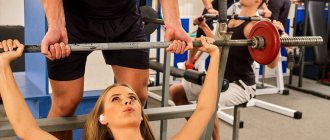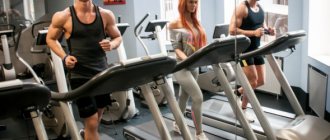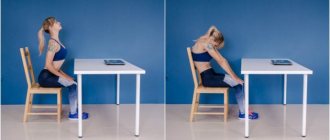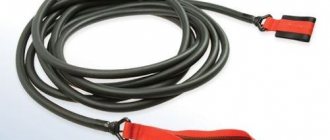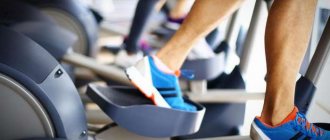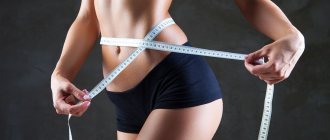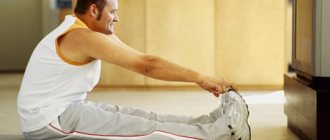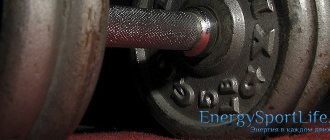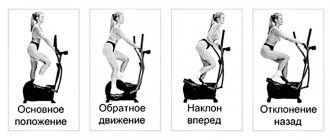High-quality fitness classes conducted in a gym are considered much more effective than home workouts. Regardless of the goal, to lose weight or gain muscle mass, in the gym a person will be able to quickly achieve visible results due to the presence of a large amount of additional equipment there.
Understanding how to independently create a training program, as well as knowing which exercises will be most effective in a particular case, an athlete will be able not only to transform his body in the shortest possible time, but also to avoid injury during exercise.
Training program
Exercises in the gym aimed at reducing the amount of subcutaneous fat should be carried out under the guidance of a professional fitness trainer.
The specialist will not only competently draw up a training program taking into account the athlete’s state of health, physical fitness, as well as the desired result of the athlete, but will also monitor his compliance with the exercise technique. This will reduce the risk of injury and the likelihood of having a “backward result” as a result of exercise.
To ensure results in the gym, you need to work out with a fitness trainer.
If it is not possible to use the services of a professional, a person can independently create a training regimen for himself, following the basic recommendations for performing physical activity for weight loss:
- include exercises for various muscle groups in a complex planned to be performed in one day (this will help to work the entire body evenly, avoiding overtraining of individual areas);
- within one workout, it is recommended to alternate exercises that differ in their focus (strength and cardio; “pull-push” and so on. This will help to avoid premature overwork of the body and do the maximum number of approaches);
- as the final part of the workout (cool-down), you should use high-intensity cardio (helps accelerate metabolic processes, which play a major role in the process of losing weight);
- It is important to follow all stages of the lesson (cool-down, main part, warm-up, stretching exercises), since this is the only way to work out the whole body evenly, without putting a harmful strain on the cardiovascular system.
Despite the fact that cardio exercises are considered the most effective for weight loss, it is not recommended to include them alone in the program.
The same intensity maintained throughout the entire workout leads to rapid adaptation of the body and lack of results.
If there are contraindications that prevent full training (strength and cardio exercises), the athlete should arrange a training plan so that exercises to strengthen the cardiovascular system have different intensities within one workout.
To achieve this goal, those losing weight need to exercise in the gym at least 3 times a week for 2 – 2.5 hours. The number of approaches to performing each exercise should not exceed 3.
If the specified number of approaches is significantly exceeded, the athlete runs the risk of overtraining the muscles, which will subsequently lead to pain in the body due to the accumulation of lactic acid in the body.
How to create your own personal training plan
When a girl comes to the gym, she should already have a ready-made plan. Beginners are advised to work their entire body during training to strengthen their muscles. To do this, the complex can include 2-3 exercises for large muscles (chest, back, lower limbs), then 4-5 for secondary muscles (shoulders - legs, biceps - back, triceps - chest). Don't forget about warming up and stretching.
It is better for a beginning athlete to take the basic complex as a basis and adjust it at her own discretion. However, it should be remembered that its specifics depend on goals and age.
When creating a gym routine, take into account your body type and physical fitness. If you are working out for the first time or after a long break, then create a simple complex. After strengthening the muscles, you can slightly increase the load. The training plan needs to be changed every month.
Warm-up
The warm-up should consist of exercises, the intensity of which usually increases as the introductory part of the complex is completed. At this stage, the athlete’s goal is to maximally prepare the muscles for further training, accelerate metabolic processes, and also set the breathing rhythm for subsequent load.
The most effective warm-up exercises are:
| Exercise | Number of repetitions | Execution algorithm |
| Neck muscle stretch | 3*10 | 1. Stand up straight; place your feet shoulder-width apart; place your hands in the waist area; move your chest forward slightly; stretch your neck. 2. Slowly tilt your head towards your right shoulder and, having felt the stretching of the neck muscles as much as possible, smoothly return to the starting position (IP). 3. Repeat step 2, tilting in the opposite direction. 4. Repeat step 2, tilting your head forward. 5. Repeat step 2, tilting your head back. 6. Turn your head to the right, as if trying to touch your shoulder joint with your chin. Hold the position for 3 seconds, then return to IP. 7. Repeat step 6, turning your head to the left |
| Head rotation | 5 for each side | 1. Stand up straight; put your legs in a free position; raise your chin; Place your hands on your belt. 2. Draw a circle with your head in the air (left shoulder - forward - right shoulder - back) |
| Circular swings of arms | 2*10 | 1. Take a vertical position; move your chest forward slightly; place your hands along the body. 2. Perform rotational movements with your arms, using the shoulder joint |
| Lateral core stretch | 20 | 1. Stand up straight; place your feet at a distance equal to shoulder width; Place your hands on your belt. 2. Tilt the upper body to the right, while making sure that the pelvis remains motionless. 3. Return to IP and repeat step 2, performing a similar tilt to the left |
| "Lock" | 30 sec. | 1. Stand up straight; move your chest forward slightly; clasp your hands behind your back, bending your spine forward in the thoracic region. 2. Fix the position for the specified amount of time, stretching the chest muscles as much as possible. 3. Slowly relaxing, return to the IP |
| Circular movements of the knees | 20 times for each direction | 1. Place your feet as close to each other as possible; close your knees; place the backs of your hands on your knees, slightly bending your lower limbs; back straight. 2. Without spreading your knees apart, make the required number of rotational movements with your knee joints, while making sure that the upper part of the body remains motionless |
Don't miss the most popular article in the section: Body drying for girls. Training program, detailed nutrition menu for the month by day.
Carry a towel with you
Sports clubs make people work hard. Wipe down the equipment after use and place a towel on the machine under your head. Fitness clubs are places where a large number of germs accumulate. If someone leaves sweaty equipment behind, do yourself a favor and wipe it down. Then do others a favor by leaving the machine cleaner than when you started using it!
6. Forget about your phone
Keep your phone locked (see point 4). Checking your phone can completely disrupt the intensity of your workout. Gym selfies and text messages are real workout mood killers. If you need your own music for practice, it is better to use an MP3 player. Maintaining concentration is key here!
Cardio exercises
Classes at the gym should include both strength training and cardio exercises. Theoretically, you can strengthen the cardiovascular system with any exercise performed with minimal weights at a fast pace.
One of the most effective cardio complexes for weight loss is training on the most popular exercise machines, which includes:
| Exercise | lead time | Execution algorithm |
| Running on a treadmill | 20 minutes. | The intensity of exercise should be chosen taking into account the weight of the athlete. If a person’s body weight exceeds 85 kg, you should not exercise vigorously on a treadmill, thereby injuring joints and bones, as well as negatively affecting the cardiovascular system. If you are overweight, it is enough to walk at a moderate pace, controlling the frequency and depth of breathing. If the athlete’s body weight is relatively normal, transformation in his case will require running, which involves a gradual increase in speed and inclination angle (the indicator is set by the functionality of the treadmill) |
| Walking on a stepper | 20 minutes. | The stepper is suitable for people who do not have diseases of the joints and skeletal system. Exercises in such a simulator involve energetic alternating bending of the legs, resting the feet on the pedals of the device.
|
| Riding an exercise bike | 20 minutes. | Exercises are the safest, since the load on the heart during their implementation is as close as possible to natural (for example, during a light jog in the fresh air). Modern exercise machines that simulate cycling allow a person not only to independently set the level of resistance, but also to control the pulse range, which when losing weight should vary from 120 to 140 beats per minute. |
Cardio training is recommended to be performed in a well-ventilated area to ensure full access of oxygen to the body. Otherwise, during the exercise, the athlete may experience dizziness, nausea, a sharp drop in blood pressure and a feeling of lack of air.
Features of muscle physiology
Muscle tissue connected to the skeleton forms the structure of the human body. A person has about 600 different muscles, each of which has its own separate functions and characteristics. They consist of elastic elastic fabric. Their contraction moves individual parts of the body.
When performing various actions, not just one, but groups of muscles work. The more local the movement is, for example an exercise aimed at a specific group, the less they will contract.
Strength is characterized by the maximum weight that a muscle can lift when contracted. Depending on their location on the body, they are divided into groups.
There are muscles:
- Hand.
- Nog.
- Press.
- Necks.
- Breasts.
Each group takes on separate types of loads. Therefore, exercises on simulators are divided into categories of working body parts.
Strength exercises
Classes in the gym, in particular their main part, must include strength exercises. Depending on the equipment of the gym, as well as the characteristics of a particular workout, this type of load can be performed using weights or with your own weight.
Bodyweight training
| Exercise | Approaches*number of repetitions. | Execution algorithm |
| Walking on the forelimbs | 3*45 sec. | 1. Place your feet at a distance equal to the width of the hip bone; straighten your back. 2. Bend forward and rest the backs of your hands on the floor, placing them in front of your feet. 3. Smoothly transfer the main part of the weight to the forelimbs and, alternately placing them forward, take several “steps” until a straight line is formed passing through the entire body. 4. Without pausing, in similar “steps”, but in the opposite direction, move your hands to the IP. |
| Torso rotations from a sitting position | 4*20 | 1. Sit on a hard surface; bend your legs at the knees and place them in front of you; place your hands on the back of your head; straighten your back. 2. Slightly move your body back without changing the position of your back; lift your feet off the supporting surface. 3. Turn the body to the right and at the same time pull up the lower limb of the same side of the body, while stretching the other as much as possible. 4. Return to IP, then repeat step 3, turning in the opposite direction |
| Squats followed by a jump | 4*15 | 1. Place your feet at a distance equal to shoulder width; straighten your back; move your chest forward slightly; fix your hands on your belt. 2. As you exhale, bend your knees, bringing your buttocks closer to the floor until a parallel is formed between the floor and the back of the thigh. 3. Straighten your lower limbs with a jerking movement and, without stopping in the IP, jump as high as possible. 4. Repeat steps 2-3 as many times as necessary |
Weight training
Weight training is recommended only under the supervision of a professional fitness instructor who is in the gym during the training period. He will be able not only to monitor the correctness of the exercises, but also to provide insurance in the case of an athlete working with heavy weights.
| Exercise | Approaches*number of repetitions. | Execution algorithm |
| Dumbbell bench press | 3*15 | 1. Sit on a horizontal surface, pressing your back as tightly as possible against it; take dumbbells of the required weight in your hands and press them to the chest area; rest your feet on the floor. 2. Inhale deeply, and then “squeeze” the dumbbells with a powerful force so that at the top point they are above the chest area. 3. Without stopping in the upper position, slowly bend your arms at the elbows, returning them to the IP |
| Deadlift (using a barbell) | 4*30 | 1. Stand up straight; place your feet shoulder-width apart; fix the barbell with the required number of weights in your hands; stretch your neck; bend your back slightly forward in the thoracic region. 2. Lean forward without bending your knees and back. 3. Touch the barbell to the floor in the area of the tips of the toes, then immediately, avoiding jerking, return to the IP |
| Lunges with dumbbells | 4*20 for each leg | 1. Position yourself vertically; hold sports equipment of the required weight in your hands; straighten your back; place your feet together. 2. Take a step with your right foot; bend it at the knee, then lower your body to the floor until the knee of your left leg touches the support. The weight when a person is at the lowest point should be equally distributed between both limbs. 3. Return to IP, avoiding sudden movements, then repeat step 2, taking a step with your left foot |
Video about gym classes for beginners
Not all girls know what beginners should do in the gym. They don’t understand which machine to use, what exercises to start with, how many to do, etc. You need to act according to this plan:
- First you need to choose a gym. Agree with the administration about a free trial session. Look at the set of exercise equipment, their condition, the number of visitors, the cleanliness of the gym, locker rooms, etc.
- Determine the main goal of training: losing weight, building muscle mass, drawing relief, increasing strength and endurance.
- Even if a beginner girl plans to conduct classes in the gym without a trainer, at first she needs the help of a specialist. Therefore, it is recommended to conduct an introductory training with a trainer who will tell you what exercise equipment to pay attention to, what exercises to perform and how to do it correctly.
- Take a towel with you.
- Do not borrow equipment during the pause between sets and ask permission from other athletes to borrow it.
- After use, put the sports equipment back in its place.
- If you don't know how to use the machine, ask a trainer or a more experienced bodybuilder.
- Keep to your gym schedule.
It is better for a girl to start with simple exercises with light dumbbells, kettlebells, a barbell, a fitball, and an elastic band. This equipment will help you strengthen your muscles so you can move on to more complex workouts.
If desired, novice athletes can use ready-made programs for weight loss or muscle building. Classes in the gym should be carried out three times a week, and the effect will be noticeable after 4 weeks.
| Day 1 | Day 2 | Day 3 |
| Cardio for warming up – half an hour. | Cardio – half an hour. | Warm-up – half an hour. |
| Perform hyperextension. | Do the mountain climber exercise. | Perform loaded hyperextension. |
| Squat with a weight (barbell). | Squat with weights. | Squat down (legs wide apart, toes pointed out) with the weight. |
| Do lunges in place with weights. | Perform weighted lunges. | Do back lunges in Smith. |
| Spread/close your legs in the exercise machine. | Press the vertical platform with your feet. | Perform a deadlift. |
| Bend your legs in the machine while lying face down. | Pull the top block towards the back of your head. | Raise the dumbbells towards your biceps. |
| Extend your legs while sitting. | Raise your arms with dumbbells while standing. | Do overhead rows to the chest on the machine. |
| Pull the lower block towards your chest. | Press dumbbells while leaning on a bench. | Do pull-ups with the support of an assistant. |
| Perform crunches on a bench with a downward slope. | Do push-ups in graviton. | Pull your knees to your chest on the horizontal bar. |
| Do a cardio workout for 15 minutes. | Perform crunches. | Do crunches on a bench. |
| Stretch for 5 minutes. | Cardio – 10 minutes, stretching – 5 minutes. | Aerobic exercise – 10 minutes, stretching – 5 minutes. |
This weekly complex involves visiting the gym 3 times in 7 days. Each element must be repeated 15 to 18 times three or four times. A beginner athlete should use minimal weight. Pause between sets – from 60 to 90 seconds.
Fitness program
| Day 1 | Day 2 | Day 3 |
| Do a joint warm-up - from 10 to 20 minutes. | Warm up for about 20 minutes. | Warm up for 15 minutes. |
| Perform hyperextension. | Do burpees (squat jumps). | Twist the body. |
| Twist the body onto the press. | Raise your legs while hanging on the horizontal bar. | Squat with weights. |
| Squat with a barbell. | Perform a deadlift. | Walk with dumbbells in lunges. |
| Walk lunges with projectiles. | Do backward lunges in a Smith machine. | Press the barbell while standing from your chest. |
| Bring your arms together in a butterfly motion. | Bench press the barbell. | Pull the apparatus (barbell, kettlebell) to your chin. |
| Raise your arms with dumbbells. | Perform overhead rows on the machine with a narrow grip. | |
| Press the dumbbell. | Do push-ups or pull-ups (wide grip). | Pull the dumbbell from behind your head while lying down. |
| Pull the top block towards your head. | Do crunches. | Twist the body onto the press. |
| Perform muscle stretching exercises – 5 minutes. | Stretch for 5 minutes. | Stretching – 5 minutes. |
The girl must perform each element from 6 to 12 times with maximum weight. The pause between sets is 2 minutes.
Exercises on simulators
Classes in the gym, especially those aimed at reducing a person’s body weight, involve performing a number of exercises in simulators and complex installations. During the first lesson, it is recommended to set the minimum load, gradually increasing it in the future as the body gets used to it.
| Exercise | Approaches*number of repetitions. | Execution algorithm |
| Leg press | 3*20 | 1. Be located in the structure of the simulator; press your back to the supporting surface; rest your feet on the moving block; Grab the metal handles with your hands. 2. As you exhale, straighten your legs, using muscle efforts to lift the moving block. 3. Return to IP and, without resting during one approach, repeat the exercise the required number of times |
| Upper block pull | 3*25 | 1. Stand facing the side of the simulator structure; grab the handle with your hands, having previously selected the required level of weight; Place your feet shoulder-width apart; Bend your back slightly forward, moving your buttocks back. 2. Releasing the air that was previously drawn into them from the lungs, pull the handle towards you until the hands are at the level of the lower abdomen. 3. Avoiding jerking, slowly relax your arms, thus taking the original position. |
| "Butterfly" | 3*20 | 1. Sit on the supporting part of the simulator; fix your hands in the movable platforms; rest your feet on the floor. 2. As you exhale, bring the moving platforms together, using the chest muscles as much as possible. The back and legs should remain motionless. 3. After holding for 2-3 seconds, slowly return to IP, relaxing the pectoral muscles as much as possible |
| Breeding legs in the simulator | 3*15 | 1. Sit in the exercise machine, placing your legs in the movable blocks and pressing your back to the supporting surface. 2. Using a powerful force from the muscles of the outer surface of the thigh, move the movable blocks to the sides. Take a pause of up to 5 seconds. 3. Gradually relaxing the muscles, allow the legs to slowly accept the IP |
| Leg abduction in the simulator | 3*15 | The principle of performing this exercise is similar to the above. The only difference is the direction of movement of the moving platforms. In this case, the athlete needs to bring his legs together (using the muscles of the inner thigh), preventing the resistance set by the simulator |
| Pull the lower block towards you | 4*20 | 1. Sit in the simulator; straighten your back; press your feet firmly to the floor; Fix the movable handle in the hands. 2. Simultaneously with exhalation, pull the lower block towards you, making sure that the position of the body remains unchanged. 3. Without pausing during the exercise, return your hands to their original position as slowly as possible. Repeat the exercise as many times as necessary |
Don’t miss the most popular article in the section: Glutamic acid - what it is, why and how it is used in sports and bodybuilding.
How to choose exercises for a woman
Beginning athletes in the gym should perform exercises to pump large muscle groups, for example, chest, back, and then shoulders, biceps/triceps, forearms, wrists, or first the gluteal muscles, and then the thighs, calves. The workout can include cardio, strength, basic, and isolation elements.
If a girl’s weight is normal, then she can do strength training exercises without cardio to increase her mass. General strengthening training is suitable for those who want to stay in shape and work out all the muscles in the gym.
The choice of exercises depends on the girl’s goals. If an athlete wants to lose weight, then she needs to work on a fat-burning program in the gym. To do this, you need to exercise on a treadmill, exercise bike, orbit track, or stepper. This is the most popular equipment that will help remove excess fat and tighten muscles. Minimum operating time is 30 minutes.
Most novice athletes want to remove belly fat. They should know that excess calories are lost evenly from the entire body (somewhere more, somewhere less), so the whole body will lose weight, and not just one part of it. Only then, after the fat layer has been reduced, can the shape be adjusted.
To lose weight, a girl can combine aerobic (cardio) and strength training. Combined exercises for beginners will help you lose weight and build muscle. Power movements are performed 12-20 times three times quickly and with minimal weight. The pause between sessions is from 40 to 60 seconds.
Aerobics and circuit training are also good for weight loss. The last type of training consists of performing each exercise for 1 set without a pause, then the girl rests for 1-2 minutes, after which she does the second round, etc.
Effective strength training for beginners helps build muscles. To do this, the girl performs basic/isolating exercises from 6 to 12 times with heavy weight. This can be a full-body workout or a split program, when in 1 day you need to pump up a specific muscle group (buttocks, legs or chest, shoulders, arms). The pause between sets is 2 minutes. Cardio can only be used for a warm-up or gentle cool-down.
To lose weight in the legs, buttocks, abdomen and other parts of the body, cardio exercises are recommended, which increase heart rate. During training, it speeds up metabolism and burns fat faster. These types of activities include not only cardio exercises, but also jumping rope, running, swimming, special exercises, for example, “climber”, burpees, etc.
Popular strength movements in the gym for beginners:
- Squat with weights (dumbbells, barbell). While lowering your pelvis, keep your back straight, tilt your body slightly forward, move your buttocks back, and press your heels to the floor.
- Do lunges (while standing or walking). At the lowest point, the knee of the front leg should not go beyond the toe, the back is straight, the torso is slightly tilted forward.
- Perform barbell deadlifts without weights to tone your lower body as well as your back. While squatting, you need to smoothly transfer the weight to your buttocks.
- Do barbell presses (without weights) to pump up your chest, triceps, and deltoids.
- Perform abdominal crunches with your feet elevated.
- Do a plank (straight, on your side, with your arm or leg raised). And if you stand on an unstable support, the load on the muscles will increase.
- Raise your knees to your chest on the horizontal bar.
These exercises for beginners will help accelerate muscle growth and make the relief more pronounced.
If a girl prefers to exercise on simulators, then she can include the following elements in the program:
- Press a block with your feet in the simulator. If the feet are placed on the upper part of the platform, then the load on the buttocks and biceps of the thigh increases, from below - on the quadriceps muscle, with a narrow position of the legs - on the outer part of the thigh, with a wide position - on the inner.
- Extend your legs in the exercise machine. Make sure that your shin is against the floor and do not fully extend your knee.
- Pull the lower block towards your stomach by tensing your back to pump it up. Fix yourself and try to bring your shoulder blades together as much as possible.
- Pull the upper block towards your chest to pump up your back.
- Bring your arms together to pump up your chest. Do not straighten your elbows completely, move smoothly.
- Do push-ups to put more stress on your chest, tilt your torso slightly forward.
- Extend your arms on a block to pump up your triceps. Do not arch your back, fix your elbows near your waist.
To find out your working weight, try performing the exercise with a barbell or light dumbbells. If you were able to complete the specified number of repetitions without straining, take the next-highest weight dumbbells or hang 2.5 or 5 kg weights on the barbell. It's still easy - hang it some more. Your weight is the one at which at the end of the set you find it difficult to perform the exercise, but your technique does not suffer.
Stretching and flexibility exercises
Technique:
| Exercise | Repetitions | Execution algorithm |
| "Reverse hitch" | 2 minutes. | 1. Stand up straight; place your arms and legs in a free position; raise your chin slightly; stretch your neck. 2. Bend your right arm and lower your forearm behind your back, placing your palm on the shoulder blade area. 3. Bend your left hand and place it behind your back from below, trying to touch the fingers of your right hand with your fingertips. 4. After stretching the muscles in this position for 30 seconds, switch hands |
| Front thigh stretch | 2 minutes. | 1. Stand up straight; place your feet as close to each other as possible; move your chest forward slightly; place your hands in a free position. 2. Bend your left leg and move it back, securing it with the hand of the same side behind the ankle. Gently pull your leg up, thus stretching the front of your thigh. 3. Repeat step 2, stretching the right leg |
| Stretch from the wall | 2 minutes. | 1. Stand facing the wall, leaning on it with the backs of your hands; bend your right leg slightly at the knee and place it close to the wall; Move your left foot back a distance equal to 1 step. 2. Increase the bend angle in the knee joint of the right leg, while making sure that the heel of the left leg remains pressed to the floor and the left limb itself is straight. 3. Repeat step 1 – step 2, swapping the right and left legs |
Sports activities carried out in a gym not only contribute to the athlete’s weight loss, but also to the overall health of his body, as well as strengthening the muscle corset. In order to avoid injury during exercises, you need to familiarize yourself with their technique in advance, and also make sure that the training set used is correct.
Article design: Mila Friedan
How many approaches and repetitions to do
Beginners are advised to perform high repetitions with light weight. This approach provides:
- The rapid formation of the neuromuscular connection necessary to increase muscle mass.
- Active growth of muscle mass.
- No injuries from heavy weights.
To simplify the program, perform the same number of sets and reps for all exercises. Perform all of the exercises below for three sets of 10 reps unless otherwise noted.
Proper nutrition
When training in the gym, it is important to follow the basics of proper nutrition. Food helps maintain a healthy state, proper fat burning and muscle growth. It is important for athletes to eat foods rich in protein. It includes: eggs, cottage cheese, chicken meat. It promotes muscle development.
Don't forget about fast carbohydrates, greens and foods containing calcium. It will strengthen the musculoskeletal system. It is also especially important to drink a lot of water, since during training the body loses it in large quantities.
Working out both at home and in the gym, together with the right diet, will lead to a beautiful and healthy shape. But achieving this result is not possible without following the correct technique. Therefore, before visiting the gym on your own, it is important to familiarize yourself with the theory, and during training, follow all the recommendations and instructions of the trainer.
Alexandrova Anastasia
Nutrition and healthy lifestyle specialist and author of myfitnesblog.com. For many years, she has successfully helped women and men lose weight and maintain a beautiful figure.
How to work out in the gym without a trainer?
When starting independent training in the gym, you should study in advance the principle of operation of the main simulators and follow the mandatory structure of any training. It includes warm-up, training on exercise machines, and finishing exercises.
- At the main stage, the muscles must be loaded in a certain sequence. The hips and legs are worked on first. After them, they begin to load the pectoral muscles and back, then the shoulders and arms. The work on the simulators is completed by pumping the rectus and oblique abdominal muscles.
- When practicing, be sure to monitor the correct body position and clarity of movements. The load is selected depending on physical fitness. The weight should not be too heavy. It should allow you to perform 2 - 3 sets of 10 - 15 repetitions. With each workout, the load on the machines is gradually increased.
- The final stage will allow you to relax muscles that are tense due to training and prevent pain in them the next day. Cardio exercises help with this. About 5 minutes on a treadmill, exercise bike or elliptical at an easy pace will start the process of muscle tissue restoration and relieve severe tension.
Where to start training in the gym?
- Any workout, especially in the gym, begins with preparing the body for physical activity. Warm up for 10–15 minutes. It is divided into 4 main stages: warming up, spinning, warming up and stretching.
- During the first part, you need to warm up the body with simple intense exercises. Most often this is running, jumping rope, boxing at an easy pace. During these 3-5 minutes, the muscles should warm up and become softer and more elastic.
- Rotations will prepare stagnant joints for active work. Exercises are performed on all parts of the body from top to bottom. This complex will protect against injuries in the joint area during heavy loads.
- At the main stage, a couple of simple exercises are performed for general warm-up and additional warming up of the body . You can jump in place, clapping above your head, squat, and do dynamic bends to each side and to your feet.
- The final part is stretching. It helps increase the elasticity of muscles and ligaments. Be sure to work out the arms, legs, inner thighs and back. This set of exercises prevents accidental sprains and tears of ligaments and joints.
Warm-up cannot be neglected. Thanks to it, training becomes not only safe, but also more effective.
The most common mistakes in the gym
All beginners make mistakes during training. Some of them are not very critical, others are more significant and affect the effectiveness of the training.
Among them are the most common:
- Unchanging training program. If you do the same exercises day after day, your muscles will quickly get used to it and stop developing. You need to alternate loads on different muscle groups and change the program at least once a month.
- Lack of rest. Daily training will not give greater results. Muscle tissue needs periodic breaks to grow and repair. It is enough to visit the gym 3 times a week.
- Water during classes. You should drink after completing exercises. If you are very thirsty, just wet your lips, rinse your mouth, or take 1-2 small sips.
- Wrong shoes. Often beginners go to the gym in flip-flops or sandals. These shoes are not suitable for sports and do not support the foot correctly. It can lead to dislocations and sprains.
- Incorrect technique. This is the most common mistake. Violations of the technique do not fully or not load the necessary muscles at all. Because of this, the exercise becomes ineffective. In addition, it can lead to injury.
- Maximum loads. If you overload the body, it will respond with severe muscle pain and stiffness of movement. Loads should be moderate but regular.
How to exercise correctly?
On the elliptical trainer
- When walking on such a simulator, the athlete’s legs move along the trajectory of a natural ellipse, from which it gets its name.
- During the movement, the hands clasp the handrails, which move in the opposite direction from each leg.
- The feet can be positioned in the way that is most comfortable.
- The closer they are to the edge, the greater the load will be.
- When exercising on this apparatus, the muscles of the legs, hips, buttocks, arms, abs and pectoral muscles are involved.
- The elliptical machine can be considered a complex exercise machine.
- While moving, you need to monitor the smoothness of your step and do not make sudden movements.
- The center of gravity of the body should always be in one place, distributing the load evenly, and not be transferred from one leg to the other.
- Losing weight requires long enough workouts at a calm pace.
- If you do not use other equipment, the duration of the lesson can reach from 40 minutes to 1 hour.
- To gain muscle mass, calm work is combined with sharp short increases in load.
- To do this, add resistance to the elliptical trainer or sharply increase the pace of movement.
- Popular models of the simulator are Torneo models.
- You can also use an elliptical trainer after a stroke. Only training needs to start with a small amount of time.
On a rowing machine?
- The rowing machine imitates the movements made while rowing a boat.
- Being a cardio exercise machine, it also uses the muscles of the upper body: arms, shoulders, back and abs.
- The technique of working with this projectile is reminiscent of performing a deadlift.
- At the starting point, the athlete’s back is straight, his legs are tense and bent at the knees, his arms are extended and tightly grip the handle.
- To perform the movement, a person pushes off with his legs, straightening them, and pulls the projectile towards himself towards the belt. At the same time, the body leans back slightly.
- To return to the starting position, the tension on the handle is loosened, the body moves forward, and then the legs bend.
During the lesson, you can periodically change your grip, and take short breaks every 10-15 minutes to rest.
Skiing on the trainer?
- The ski trainer is a cardio type and is similar in principle to an ellipsoid. It more accurately simulates the movements made when skiing.
- There are varieties: classical and mountain simulators. But the elliptical view is more popular.
- The legs, standing on the platforms, take steps, and the hands, holding the handles, work in the opposite direction.
- You should exercise on such a machine for about an hour, several times a week.
- In this case, intervals of acceleration and deceleration of the step should alternate.
- The workout ends at a calm pace to restore your heart rate.
On a stepper?
- The stepper (or step simulator) has another name - steps.
- He got it because the projectile simulates a person climbing stairs.
- When performing steps, the gluteal, calf and thigh muscles work. When exercising on this apparatus, it is important to maintain an even posture.
- Movements should be clear, but not sharp, without jumps. When moving, the body leans slightly forward, the knees do not come together.
- If the step machine has handrails, then you just need to hold onto them without leaning or transferring your body weight on them.
- During the workout, the pace alternates. The time of the first lesson starts at 10 minutes and gradually increases with each new session, creating a load that is comfortable for the body.
On street trainers?
Outdoor exercise machines differ from those found in gyms only in that they do not have load adjustment and control of training parameters, such as distance traveled and heart rate.
Most often in courtyards and parks they install:
- Ellipsoids.
- Vertical traction.
- Exercise machines for various types of bench press.
- Hyperextension.
- Abdominal handrails.
- Pull-up bars.
Training on such equipment is no different from training in the gym. Before physical activity, a warm-up is performed with a more intense warm-up than in the gym.
Outdoor weather conditions are often much colder than indoors. When working on such simulators, you need to be more careful than in the gym, since they are rougher and more traumatic.
On weight machines?
Strength trainers are divided into types:
- Using the athlete’s own weight – parallel bars, hyperextension, horizontal bar, abdominal bench.
- Using artificial weight - various stations with built-in weight.
- Using free weights - an athletic bench and various rows.
Working with any of these simulators requires a thorough warm-up.
All movements must be performed correctly and clearly, but at the same time smoothly. In strength training, sudden movements and jerks are not allowed. Additional weight or force increases the risk of injury and damage. Therefore, it is important to follow safety precautions.
Additional weight is selected based on the athlete’s physical fitness. It shouldn't be too big. Ideally, the additional load should allow you to perform 2-3 sets of 10 times without overstraining the body. In the process of further training, the load gradually increases as you get used to it.
On the machines in the gym?
Exercise machines differ in their purpose for specific muscle groups or actions. They come in various models and manufacturers. Some of the most popular brands are “House fit” and “Torneo”. They are purchased both for home use and for specialized gyms.
When exercising in gyms equipped with simulators, you must follow certain rules:
- Each workout should have a warm-up and cool-down to prevent accidental injuries.
- When working with training equipment, each athlete is obliged to follow safety precautions and perform the exercise correctly.
- Training should be regular and comprehensive. Each time the emphasis is placed on one of the muscle groups. But at the same time, the exercises should not be monotonous; almost the entire body is involved.
- Classes are not attended on a full stomach. You can train a couple of hours after eating.
- All recommendations and adjustments made by the trainer for performing the complexes must be followed.
These rules help to avoid injuries and damage to work equipment. And most importantly, a positive training result will be achieved: losing weight and gaining the right muscle mass.
On a Leg Press machine?
- Leg press is translated as leg press.
- This simulator consists of a bench on which the athlete lies and a footrest.
- The feet are placed straight at a short distance from each other, the knees are bent at an angle of 45 degrees.
- Movements are carried out by bending and straightening the legs at the knee joint under the weight of the platform.
- When working on such a setup, all leg muscles are used: calf, quadriceps and gluteus maximus.
- While working, it is important to keep your back straight and not arch your lumbar region. Movements should be smooth, without sudden jerks or throwing the platform.
On hyperextension?
- This machine is a bench with supports for the feet, hips and bolsters to support the legs.
- It performs the movement of flexion and extension of the back at the waist.
- The athlete rests his feet on the machine and lowers his body down, bending over the machine to an angle of 60 degrees.
- After this, the body rises to its original position.
- This simulator uses the muscles of the back corset, abs, buttocks and back of the thigh.
- When performing, the arms are kept crossed on the chest or locked behind the head and do not help in the execution.
- In the second variant of the placement of the arms, the elbows should not follow the direction of movement, but should be kept straight.
- When going down, inhale, and when going up, exhale.
- All movements are smooth, without sudden swings.
- Do not lower the body too low or move too far at the top.
- The back is straight when moving, does not bend in the lumbar region.
On a trainer bike?
- This simulator is as similar as possible to regular cycling.
- While moving on it, your feet should be positioned straight on the pedals, resting on the entire surface.
- The posture remains straight, with a slight tilt of the body forward.
- A bicycle is considered a cardio exercise machine.
- It involves the calf muscle and quadriceps.
- When working with the machine, it is important to monitor your pulse and even breathing.
- Classes should be long, and the power should be adjusted to the desired load.
On the ab bench?
- This exercise machine is a bench located at an angle and a support for fixing the legs.
- The athlete is positioned upside down, legs bent and feet placed behind the support.
- The lower back is pressed tightly to the surface.
- Hands are clasped behind the head. Elbows are separated and do not reach forward.
- While lifting, the neck continues the spine; the chin should not reach towards the chest.
- When performing, the body rises to its maximum point. First, the shoulders come off the bench, then the back.
- The lift is made to a right angle with the legs. The body is fixed in this position for a couple of seconds and smoothly lowers.
- You cannot jerk off the bench and throw your body while lowering. Exhale as you rise, and inhale as you lower your body.
- Breathing should be constant and measured. Bending is accomplished precisely by the abdominal muscles; weight should not be placed on the legs.
- In this case, the exercise will be ineffective.
In addition to simple curls, you can perform other exercises. Crunching is another variation of the abdominal exercise. It does not involve the lower back and pelvis. Only the shoulder blades come off the bench. Movements are performed frequently, at a fast pace, but without jerking.
For a bicycle, the athlete positions himself in reverse, grabbing the stops with his hands. The legs are bent at the knees to a right angle and raised perpendicular to the body. In this position, pedal for 30 seconds to 1 minute. It is important not to put the load on your arms, but to perform movements using the abdominal muscles.
The abdominal muscles work primarily on the bench. The back and hamstrings are also involved. For the effectiveness of the lesson, 3 approaches are performed, each of them contains 10-15 lifts and lowerings.
Using a Nordic walking machine?
- This simulator is similar to a stepper or ellipsoid.
- The legs are placed on platforms, the hands hold on to levers that move in the opposite direction to the legs.
- Its difference is that the legs do not move in a vertical plane, but in a more horizontal, straight trajectory.
- The apparatus maximally imitates the movements performed during Nordic walking classes.
- It falls into the cardio category and uses the maximum number of muscles.
- But more attention is paid to the work of the legs and shoulders.
- Nordic walking at a moderate pace is great for completing your workout in the gym, although it can also be a core exercise.
- In this case, it should be more intense and longer.
On a Smith machine?
- The Smith machine is suitable for loading the buttocks, legs during squats and the chest, arms and shoulders during various presses. Great for girls.
- The Smith machine allows beginners to perform a number of exercises for targeted muscle training.
- Place your supporting leg on a bench or other elevated platform. These are actually Bulgarian lunges in Smith.
- With this exercise, the muscles of the working leg are maximally loaded, since the supporting leg is not involved in the movement.
- The gluteal muscle of the working leg is also stretched more strongly, which improves its development.
- Stand directly under the machine. Feet shoulder width apart. Conveniently place the barbell on the trapezius muscles of the back - just below the neck.
- Bend your back slightly at the lower back and look forward. Step your working leg forward a little so that when you lunge, when your thigh is parallel to the floor, the angle at the knee joint is 90°.
- As you inhale, move your supporting leg back and do a squat. Select the step width depending on your goals.
- A wide step focuses on the buttocks, a normal step focuses on the quadriceps.
- The distance between the feet should be such that the supporting leg bends at an angle of at least 90° when squatting.
- The body weight always falls on the heel of the working leg. As you exhale, rise up and put your supporting leg back. Do not straighten your knees completely.
- This will not only protect your knee joints, but also give the muscles additional static load.
